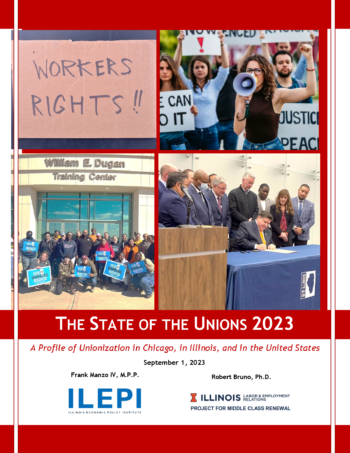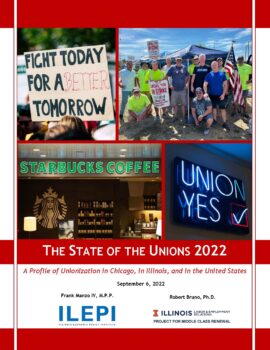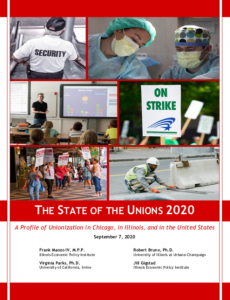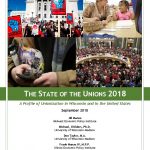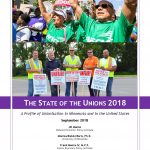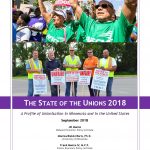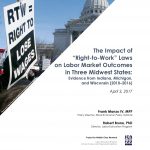
Unionization Profiles
THE STATE OF THE UNIONS 2023 | A Profile of Unionization in Chicago, in Illinois, and in the United States
Public approval of labor unions remains at a six-decade high, with bipartisan support from across the political spectrum. Data shows that union workers earn higher wages, are more likely to have health insurance coverage, and have greater access to paid leave. Though the unionization rate fell nationally for the second consecutive year, the United States added union members in 2022 for the first time since 2017. Today, Illinois’ union membership rate is about 13 percent, which is significantly higher than the national average (10 percent) and is the 12th-highest union density among the 50 U.S. states. Read full report here.
The State of the Unions 2022 | A Profile of Unionization in Chicago, in Illinois, and in the United States
Labor unions have historically delivered pathways into good, middle-class careers. Through collective bargaining, union workers earn higher wages, are more likely to have health insurance coverage, and have greater access to paid leave. A recent surge in union activity is taking place following years of worsening inequality, the COVID-19 pandemic, and a national labor shortage.
Read full report here.
THE STATE OF THE UNIONS 2020: A PROFILE OF UNIONIZATION IN CHICAGO, IN ILLINOIS, AND IN THE UNITED STATES
The COVID-19 pandemic has been a stark reminder that working people keep Illinois’ economy functioning. The workers propping up the economy were largely hourly employees who are protected most by union representation. As Illinois recovers from unprecedented job losses, the labor movement will be essential in protecting and rebuilding the state’s middle class. As Illinois and the nation recover from unprecedented job losses, the labor movement will continue to play a key role in rebuilding the middle class. However, recent membership declines suggest that it will have fewer resources available to do this important work.
THE STATE OF THE UNIONS 2019: A PROFILE OF UNIONIZATION IN CHICAGO, IN ILLINOIS, AND IN THE UNITED STATES
Chicago: On Labor Day 2019, researchers from the Illinois Economic Policy Institute, University of Illinois at Urbana-Champaign, and University of California, Irvine released the sixth annual State of the Unions report for Illinois. The study finds that unions play an important role in Illinois’ economy communities, despite declining union membership over the past decade. Since 2009, Illinois’ union membership rate has declined by 2 percentage points. After a one-year uptick, Illinois’ unionization declined from 15.0% in 2017 to 13.8% in 2018. Unionization decreased in the Chicago metropolitan area by about 12,000 members over the year. “Labor unions have recently faced many legislative and judicial setbacks including the Supreme Court decision in Janus v. AFSCME, which may have affected unionization rates,” said Professor Robert Bruno, who serves as Director of the Project for Middle Class Renewal at the University of Illinois at Urbana-Champaign.
THE STATE OF THE UNIONS 2018: A PROFILE OF UNIONIZATION IN WISCONSIN AND IN THE UNITED STATES
Union membership is influenced by a number of factors. For example, employment in the public sector still raises the chances that a given worker is a union member. Native-born and naturalized citizens are also statistically more likely to be union members than their non-citizen counterparts. On the other hand, workers employed in the leisure and hospitality industry are all less likely to be union members than their counterparts in the production industry. Labor unions continue to increase individual incomes by lifting hourly wages. In Wisconsin, union worker wages are higher by an average of 12.0 percent. The state’s union wage effect is the 7th-highest in the nation. The union wage differential is greatest for the lowest-earning workers, where hourly incomes are increased by 12.2 percent over similar non-union workers. Unions, therefore, continue to foster a middle-class lifestyle in Wisconsin and play a vital role in Wisconsin’s economy and communities.
THE STATE OF THE UNIONS 2018: A PROFILE OF UNIONIZATION IN MINNESOTA AND IN THE UNITED STATES
Unions play a vital role in Minnesota’s economy and communities. The Minnesota labor movement, however, will continue to face both short- and long-term challenges due to the political environment, the makeup of the United States Supreme Court, and broader economic trends. Labor’s response to these challenges will define its influence and effectiveness in the decades to come and will be critical to the survival of Minnesota’s middle class. Almost one-half of all public sector workers (46.0 percent) are unionized in Minnesota. Meanwhile, slightly more than one-third of all public sector workers are unionized across the nation (34.4 percent). In comparison, 8.3 percent of workers in Minnesota’s private sector are now union members which exceed the 6.5 percent unionization rate for private sector workers across the United States. In the future, the recent Janus v. American Federation of State, County, and Municipal Employees, Council 31, et al. Supreme Court decision that prohibited fair-share “agency fee” clauses from collective bargaining agreements could result in a decline in public sector union membership in Minnesota.
THE STATE OF THE UNIONS 2018: A PROFILE OF UNIONIZATION IN CHICAGO, IN ILLINOIS, AND IN THE UNITED STATES
Union membership is influenced by a number of factors. Employment in the public sector, construction, transportation and utilities, mining, educational and health services, and public administration industries all raise the chances that a given worker is a union member. African American workers are also statistically more likely to be union members than their racial or ethnic counterparts. On the other hand, workers employed in professional and related occupations, management, business, and financial occupations, workers employed in sales occupations, and financial occupations are less likely to be unionized. Labor unions increase individual incomes by lifting hourly wages, particularly for middle-income workers. In Illinois, unions raise worker wages by an average of 11.1 percent. The state’s union wage effect is the 11th-highest in the nation. The union wage differential is higher for middle-class workers (10.2 percent to 11.5 percent) than the richest 10 percent of workers (8.7 percent), helping to reduce income inequality. Unions play a vital role in Illinois’ economy and communities. The Illinois labor movement, however, will continue to face both short- and long-term challenges due to the political environment, the makeup of the United States Supreme Court, and broader economic trends. Labor’s response to these challenges will define its influence and effectiveness in the decades to come and will be critical to the long-run survival of Illinois’ middle class.
The State of the Unions 2018: A Profile of Unionization in Chicago, in Illinois, and in America
Unions play a vital role in Minnesota’s economy and communities. The Minnesota labor movement, however, will continue to face both short- and long-term challenges due to the political environment, the makeup of the United States Supreme Court, and broader economic trends. Labor’s response to these challenges will define its influence and effectiveness in the decades to come and will be critical to the survival of Minnesota’s middle class. Almost one-half of all public sector workers (46.0 percent) are unionized in Minnesota. Meanwhile, slightly more than one-third of all public sector workers are unionized across the nation (34.4 percent). In comparison, 8.3 percent of workers in Minnesota’s private sector are now union members which exceed the 6.5 percent unionization rate for private sector workers across the United States. In the future, the recent Janus v. American Federation of State, County, and Municipal Employees, Council 31, et al. Supreme Court decision that prohibited fair-share “agency fee” clauses from collective bargaining agreements could result in a decline in public sector union membership in Minnesota.
The State of the Unions 2017 : A Profile of Unionization in Chicago, in Illinois, and in America
Since 2007, unionization has declined in Illinois, in the Chicago region, and in America. There are approximately 30,000 fewer union members in Illinois today than there were in 2007, contributing to the 1.1 million-member drop in union workers across the nation over that time. Declining union membership in Illinois has primarily been the result of decreases in male unionization. Consequently, the total number of labor unions and similar labor organizations has declined over the past 10 years. There are 881 labor unions and similar organizations in Illinois, a decline of nearly 70 worker establishments over the past 10 years. While the unionization rate declined from 15.2 percent to 14.5 percent, the union membership rate for public sector workers is 5.5 percentage points higher in 2016 than it was in 2007. From 2015 to 2016, unionization rates marginally increased for Latino and Latina workers.
THE IMPACT OF “RIGHT TO WORK” LAWS ON LABOR MARKET OUTCOMES IN THREE MIDWEST STATES: EVIDENCE FROM INDIANA, MICHIGAN, AND WISCONSIN (2010-2016)
The movement to implement “right-to-work” (RTW) legislation has accelerated over recent years. Since 2012, RTW laws have been passed in Indiana, Michigan, Wisconsin, West Virginia, Kentucky, and Missouri. This report investigates the impact of RTW laws passed in three Midwest states for which there is available data – Indiana, Michigan, and Wisconsin – compared to a control group of three Midwest counterparts that remained collective-bargaining (CB) states – Illinois, Minnesota, and Ohio – from January 2010 through December 2016.
